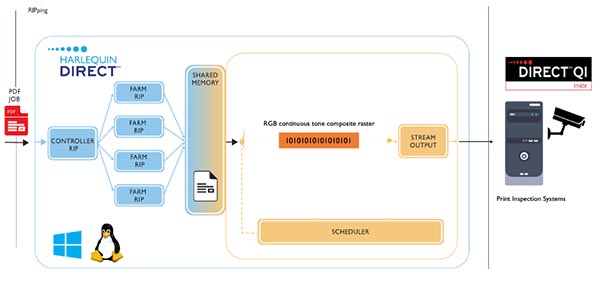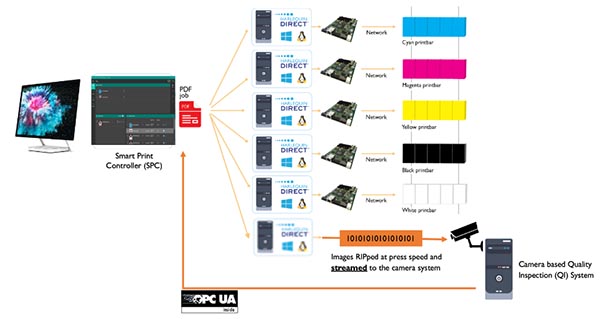(This article originally ran in the June 1 edition of the drupa daily.)
Hybrid Software today has grown organically and through the acquisition and integration of an extensive but synergetic group of companies. This has allowed them to build very complete and efficient solutions for both OEMs as well as PSP users. If we look at the increasing requirements and demands of print production, data is at the heart. It is at the core of the processes, but it can also constrain it as you start to add increased press speeds, resolutions and variable data.
These demands require even more significant and costly hardware to keep up with the presses creating a need for server farms. These server farms are beginning to look as big as the press, and adding a significant expense to the press equipment cost. Ideally, addressing this issue requires a solution from a company like Hybrid Software that has control over all of the pieces from the core infrastructure to the end user workflow.

So how do you get the data to the printhead with maximum efficiency? Harlequin Direct has accomplished this with desktop class, not expensive higher class, server CPUs using an intelligent data flow as you can see in the illustration on this page. Getting the data to the printhead only addresses part of the problem. How do you process synchronize, inspect, and compare all of that content on the fly at press speeds? Global Graphics found that their Mako SDK could be used to help address content inspection requirements where the applications are static data or offline variable data.

The Global Graphics SmartDFE suite was designed to be part of a fully automated manufacturing solution supporting Industry 4.0 telematics and MIS integration, plus connectivity with automated manufacturing lines via standard OPC UA. It brings together the creation of optimized print-ready PDF files; workflow and job automation to connect with enterprise IT systems; RIPing; screening; optimizing image quality; and, via Harlequin Direct, it then drives the print data directly to the printheads at ultra-high speeds through Meteor software and electronics, or through Xitron’s Navigator DFE platform all in one powerful solution. Since SmartDFE uses the OPC protocol, it provides industrial interoperability so it is possible to create a feedback loop from the inspection system that alerts the press which could then be directed to make adjustments, reprint pages, etc.
With SmartDFE, as seen below, you could have four machines for running the different process colors, and then a fifth generating an RGB image from the same PDF data to generate a reference image that could be compared by the VIS (Visual Inspection System). Many of the VIS systems use OpenCV, an imaging library, which can be used to compare images and through ML (machine learning) provide the systems with information that can be used to control machines and to do it at operating speed. Smart DFE is a bundle of the two products, bringing high performance print production data processing to OEMs. This solution is currently used in the Fujifilm FP790 flexible packaging press and others.

You can visit them in Hall 7a D03.
Hybride Software treibt intelligente Druckfabriken an
Hybrid Software ist heute organisch und durch die Übernahme und Integration einer umfangreichen, aber synergetischen Gruppe von Unternehmen gewachsen. Dies hat es dem Unternehmen ermöglicht, sehr umfassende und effiziente Lösungen sowohl für OEMs als auch für PSP-Anwender zu entwickeln. Betrachtet man die steigenden Anforderungen und Bedürfnisse der Druckproduktion, so stehen Daten im Mittelpunkt. Sie sind das Herzstück der Prozesse, aber sie können diese auch einschränken, wenn höhere Druckgeschwindigkeiten, Auflösungen und variable Daten hinzukommen.
Diese Anforderungen erfordern eine noch umfangreichere und kostspieligere Hardware, um mit den Druckmaschinen Schritt halten zu können, was den Bedarf an Serverfarmen zur Folge hat. Diese Serverfarmen sind mittlerweile so groß wie die Druckmaschine und verursachen zusätzlich zu den Kosten für die Druckmaschinenausrüstung erhebliche Kosten. Im Idealfall erfordert dieses Problem eine Lösung von einem Unternehmen wie Hybrid Software, das alle Komponenten von der Kerninfrastruktur bis hin zum Endbenutzer-Workflow unter Kontrolle hat.
Wie also bringt man die Daten mit maximaler Effizienz zum Druckkopf? Harlequin Direct hat dies mit Server-CPUs der Desktop-Klasse (nicht der teuren höheren Klasse) und einem intelligenten Datenfluss erreicht, wie Sie in der Illustration auf dieser Seite sehen können. Die Übermittlung der Daten an den Druckkopf ist nur ein Teil des Problems. Wie lassen sich all diese Inhalte bei Druckgeschwindigkeiten synchronisieren, prüfen und vergleichen? Global Graphics fand heraus, dass sein Mako SDK dazu verwendet werden kann, die Anforderungen an die Inhaltskontrolle zu erfüllen, wenn es sich bei den Anwendungen um statische Daten oder variable Offline-Daten handelt.
Die SmartDFE-Suite von Global Graphics wurde als Teil einer vollautomatischen Fertigungslösung entwickelt, die Industrie 4.0-Telematik und MIS-Integration sowie die Konnektivität mit automatisierten Fertigungslinien über Standard-OPC UA unterstützt. Sie vereint die Erstellung optimierter druckfertiger PDF-Dateien, Workflow- und Job-Automatisierung zur Anbindung an Unternehmens-IT-Systeme, RIPing, Rasterung, Optimierung der Bildqualität und steuert dann über Harlequin Direct die Druckdaten direkt zu den Druckköpfen mit extrem hohen Geschwindigkeiten über die Meteor-Software und -Elektronik oder über die Navigator DFE-Plattform von Xitron - alles in einer einzigen leistungsstarken Lösung. Da SmartDFE das OPC-Protokoll verwendet, bietet es industrielle Interoperabilität, so dass es möglich ist, eine Rückkopplungsschleife vom Inspektionssystem zu erstellen, die die Druckmaschine warnt, die dann angewiesen werden kann, Anpassungen vorzunehmen, Seiten neu zu drucken usw.
Mit SmartDFE könnten Sie, wie unten zu sehen, vier Maschinen für die verschiedenen Prozessfarben einsetzen und eine fünfte Maschine, die ein RGB-Bild aus denselben PDF-Daten erzeugt, um ein Referenzbild zu erzeugen, das vom VIS (Visual Inspection System) verglichen werden kann. Viele der VIS-Systeme verwenden OpenCV, eine Bildverarbeitungsbibliothek, die zum Vergleich von Bildern verwendet werden kann und durch ML (maschinelles Lernen) die Systeme mit Informationen versorgt, die zur Steuerung von Maschinen verwendet werden können, und zwar bei Betriebsgeschwindigkeit. Smart DFE ist ein Bündel der beiden Produkte, das OEMs eine hochleistungsfähige Datenverarbeitung für die Druckproduktion bietet. Diese Lösung wird derzeit unter anderem in der flexiblen Verpackungsdruckmaschine FP790 von Fujifilm eingesetzt.
Sie können sie in Halle 7a D03 besuchen.














